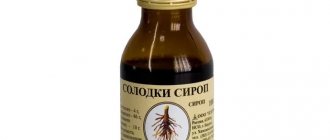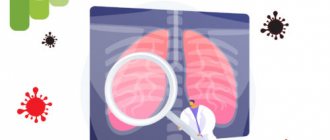Modern therapy of chronic obstructive pulmonary disease
Chronic obstructive pulmonary disease (COPD) is a disease characterized by progressive, partially reversible bronchial obstruction, which is associated with inflammation of the airways that occurs under the influence of unfavorable environmental factors (smoking, occupational hazards, pollutants, etc.). It has been established that morphological changes in COPD are observed in the central and peripheral bronchi, pulmonary parenchyma and vessels [8, 9]. This explains the use of the term “chronic obstructive pulmonary disease” instead of the usual “chronic obstructive bronchitis,” which implies a predominant lesion of the bronchi in the patient.
The recently published recommendations of leading experts from the American and European Thoracic Societies emphasize that the development of COPD in patients can be prevented, and with its treatment it is quite possible to achieve success [7].
The morbidity and mortality of patients from COPD continues to increase worldwide, primarily due to the high prevalence of smoking. It has been shown that this disease affects 4–6% of men and 1–3% of women over 40 years of age [8, 10]. In European countries, it causes the death of 200–300 thousand people annually [10]. The high medical and social significance of COPD was the reason for the publication, at the initiative of the WHO, of an international consensus document devoted to its diagnosis, treatment, prevention and based on the principles of evidence-based medicine [8]. Similar recommendations have been issued by the American and European Respiratory Societies [7]. In our country, the 2nd edition of the Federal Program on COPD was recently published [1].
The goals of COPD therapy are to prevent disease progression, reduce the severity of clinical symptoms, achieve better exercise tolerance and improve the quality of life of patients, prevent complications and exacerbations, and reduce mortality [8, 9].
The main directions of treatment for COPD are reducing the impact of adverse environmental factors (including smoking cessation), patient education, the use of medications and non-drug therapy (oxygen therapy, rehabilitation, etc.). Various combinations of these methods are used in patients with COPD in remission and exacerbation.
Reducing the impact of risk factors on patients is an integral part of the treatment of COPD, which helps prevent the development and progression of this disease. It has been established that quitting smoking can slow down the increase in bronchial obstruction. Therefore, treatment of tobacco addiction is important for all patients suffering from COPD. The most effective in this case are conversations with medical personnel (individual and group) and pharmacotherapy. There are three tobacco dependence treatment programs: short (1–3 months), long-term (6–12 months) and a program to reduce smoking intensity [2].
It is recommended to prescribe medications for patients with whom the doctor’s conversations were not sufficiently effective. A careful approach should be taken to their use in people who smoke less than 10 cigarettes per day, adolescents and pregnant women. Contraindications to nicotine replacement therapy are unstable angina, untreated peptic ulcer of the duodenum, recent acute myocardial infarction and cerebrovascular accident.
Increasing patients' awareness allows them to increase their performance, improve their health, develop the ability to cope with the disease, and increase the effectiveness of treatment of exacerbations [8]. Forms of patient education vary from distributing printed materials to holding seminars and conferences. The most effective is interactive training, which is carried out in a small seminar.
The principles of treatment of stable COPD [6, 8] are as follows.
- The volume of treatment increases as the severity of the disease increases. Its reduction in COPD, unlike bronchial asthma, is usually impossible.
- Drug therapy is used to prevent complications and reduce the severity of symptoms, the frequency and severity of exacerbations, increase exercise tolerance and the quality of life of patients.
- It should be borne in mind that none of the available drugs affects the rate of decrease in bronchial obstruction, which is the hallmark of COPD.
- Bronchodilators are central to the treatment of COPD. They reduce the severity of the reversible component of bronchial obstruction. These funds are used on an on-demand or regular basis.
- Inhaled glucocorticoids are indicated for severe and extremely severe COPD (with forced expiratory volume in 1 s (FEV1) less than 50% of predicted and frequent exacerbations, usually more than three in the last three years or one or two in one year, for the treatment of which Oral steroids and antibiotics are used.
- Combination therapy with inhaled glucocorticoids and long-acting β2-agonists has a significant additional effect on pulmonary function and clinical symptoms of COPD compared with monotherapy with either drug. The greatest impact on the frequency of exacerbations and quality of life is observed in patients with COPD with FEV1<50% of predicted. These drugs are preferably prescribed in inhalation form containing their fixed combinations (salmeterol/fluticasone propionate, formoterol/budesonide).
- Long-term use of tableted glucocorticoids is not recommended due to the risk of systemic side effects.
- At all stages of COPD, physical training programs are highly effective, increasing exercise tolerance and reducing the severity of shortness of breath and fatigue.
- Long-term administration of oxygen (more than 15 hours per day) to patients with respiratory failure increases their survival.
Drug treatment of stable COPD
Bronchodilators. These include β2-adrenergic agonists, anticholinergics, and theophylline. The forms of release of these drugs and their effect on the course of COPD are given in tables 1 and .
The principles of bronchodilator therapy for COPD [6–8] are as follows.
- The preferred route of administration of bronchodilators is inhalation.
- Changes in pulmonary function after short-term administration of bronchodilators are not an indicator of their long-term effectiveness. A relatively small increase in FEV1 can be combined with significant changes in lung volumes, including a decrease in residual lung volume, which helps reduce the severity of shortness of breath in patients.
- The choice between β2-adrenergic agonists, anticholinergics, and theophylline depends on their availability, the individual sensitivity of patients to their action and the absence of side effects. In elderly patients with concomitant diseases of the cardiovascular system (coronary artery disease, heart rhythm disturbances, arterial hypertension, etc.), anticholinergics are preferred as first-line drugs.
- Xanthines are effective for COPD, but due to the possibility of developing side effects, they are classified as “second-line” drugs. When prescribing them, it is recommended to measure the concentration of theophylline in the blood. It should be emphasized that only long-acting theophyllines (but not aminophylline and theophedrine!) have a positive effect on the course of COPD.
- Long-acting inhaled bronchodilators are more convenient, but also more expensive than short-acting ones.
- Regular treatment with long-acting bronchodilators (tiotropium bromide, salmeterol and formoterol) is indicated for moderate, severe and extremely severe COPD.
- The combination of several bronchodilators (for example, anticholinergics and β2-agonists, anticholinergics and theophyllines, β2-agonists and theophyllines) may increase effectiveness and reduce the likelihood of side effects compared with monotherapy with a single drug.
Metered aerosols, powder inhalers and nebulizers are used to deliver β2-agonists and anticholinergics. The latter are recommended in the treatment of exacerbations of COPD, as well as in patients with severe disease who have difficulty using other delivery systems. For stable COPD, metered dose and powder inhalers are preferred.
Glucocorticoids. These drugs have pronounced anti-inflammatory activity, although in patients with COPD it is significantly less pronounced than in patients with asthma. Short (10–14 days) courses of systemic steroids are used to treat exacerbations of COPD. Long-term use of these drugs is not recommended due to the risk of side effects (myopathy, osteoporosis, etc.).
Data on the effect of inhaled glucocorticoids on the course of COPD are summarized in Table 2. It is shown that they have no effect on the progressive decrease in bronchial obstruction in patients with COPD. Their high doses (for example, fluticasone propionate 1000 mcg/day) can improve the quality of life of patients and reduce the frequency of exacerbations of severe and extremely severe COPD.
The reasons for the relative steroid resistance of airway inflammation in COPD are the subject of intense research. This may be due to the fact that corticosteroids increase the lifespan of neutrophils by inhibiting their apoptosis. The molecular mechanisms underlying resistance to glucocorticoids are not well understood. There have been reports of a decrease in the activity of histone deacetylase, which is a target for the action of steroids, under the influence of smoking and free radicals, which may reduce the inhibitory effect of glucocorticoids on the transcription of “inflammatory” genes and weaken their anti-inflammatory effect.
Recently, new data have been obtained on the effectiveness of combination drugs (fluticasone propionate/salmeterol 500/50 mcg, 1 inhalation 2 times a day and budesonide/formoterol 160/4.5 mcg, 2 inhalations 2 times a day, budesonide/salbutamol 100/200 mgk 2 inhalations 2 times a day) in patients with severe and extremely severe COPD. It has been shown that their long-term (12 months) administration improves bronchial patency, reduces the severity of symptoms, the need for bronchodilators, the frequency of moderate and severe exacerbations, and also improves the quality of life of patients compared to monotherapy with inhaled glucocorticoids, long-acting β2-adrenergic agonists and placebo [ 5, 14].
Vaccines . Influenza vaccination reduces the severity of exacerbations and mortality in patients with COPD by approximately 50%. Vaccines containing killed or inactivated live influenza viruses are usually administered once in October - the first half of November.
There is insufficient data on the effectiveness of the pneumococcal vaccine, containing 23 virulent serotypes of this microorganism, in patients with COPD [8, 9]. However, some experts recommend its use in this disease to prevent pneumonia [6].
Antibiotics. Currently, there is no convincing data on the effectiveness of antibacterial agents to reduce the frequency and severity of non-infectious exacerbations of COPD.
Antibiotics are indicated for the treatment of infectious exacerbations of the disease, directly affect the duration of elimination of COPD symptoms, and some help lengthen the interval between relapses.
Mucolytics (mucokinetics, mucoregulators). Mucolytics (ambroxol, carbocysteine, iodine preparations, etc.) can be used in a small proportion of patients with viscous sputum. Widespread use of these agents in patients with COPD is not recommended.
Antioxidants. N-acetylcysteine, which has antioxidant and mucolytic activity, can reduce the duration and frequency of exacerbations of COPD. This drug can be used in patients for a long time (3–6 months) at a dose of 600 mg/day.
Immunoregulators (immunostimulants, immunomodulators). Regular use of these drugs is not recommended due to the lack of convincing evidence of effectiveness.
Patients with genetically determined α1-antitrypsin deficiency who develop COPD at a young age (before 40 years) are possible candidates for replacement therapy. However, the cost of such treatment is very high, and it is not available in all countries.
Non-drug treatment of stable COPD
Oxygen therapy
It is known that respiratory failure is the main cause of death in patients with COPD. Correction of hypoxemia using oxygen supply is a pathogenetically based treatment method. There are short-term and long-term oxygen therapy [4, 15]. The first is used for exacerbations of COPD. The second is used for extremely severe COPD (with FEV1<30% of predicted) constantly or situationally (during physical activity and during sleep). The goal of oxygen therapy is to increase the partial tension of oxygen (PaO2) in arterial blood to at least 60 mmHg. Art. or saturation (SaO2) to at least 90% at rest, during physical activity and during sleep.
In stable COPD, continuous long-term oxygen therapy is preferable [9]. It has been proven that it increases the survival of patients with COPD, reduces the severity of shortness of breath, the progression of pulmonary hypertension, reduces secondary erythrocytosis, the frequency of episodes of hypoxemia during sleep, increases exercise tolerance, quality of life and neuropsychic status of patients [3, 4].
Indications for long-term oxygen therapy in patients with extremely severe COPD (with FEV1 < 30% of predicted or less than 1.5 l):
- PaO2 is less than 55% of the expected value, SaO2 is below 88% with or without hypercapnia;
- PaO2 - 55–60% of the expected value, SaO2 - 89% in the presence of pulmonary hypertension, peripheral edema associated with decompensation of the pulmonary heart or polycythemia (hematocrit more than 55%).
Gas exchange parameters should be assessed only against the background of a stable course of COPD and no earlier than 3–4 weeks after an exacerbation with optimally selected therapy. The decision to prescribe oxygen therapy should be based on measurements obtained at rest and during exercise (eg, a 6-minute walk). Re-evaluation of arterial blood gases should be performed 30–90 days after the start of oxygen therapy.
Long-term oxygen treatment should be carried out for at least 15 hours a day. The gas flow rate is usually 1–2 l/min; if necessary, it can be increased to 4 l/min. Oxygen therapy should never be prescribed to patients who continue to smoke or suffer from alcoholism.
Compressed gas cylinders, oxygen concentrators and liquid oxygen cylinders are used as oxygen sources. Oxygen concentrators are the most economical and convenient for home use.
Oxygen is delivered to the patient using masks, nasal cannulas, and transtracheal catheters. The most convenient and widely used are nasal cannulas, which allow the patient to receive an oxygen-air mixture with 30–40% O2. Oxygen is delivered to the alveoli only in the early phase of inspiration (the first 0.5 s). The gas arriving later is used only to fill the dead space and does not participate in gas exchange. To increase delivery efficiency, there are several types of oxygen-saving devices (reservoir cannulas, devices that supply gas only during inspiration, transtracheal catheters, etc.). In patients with extremely severe COPD who have daytime hypercapnia, the combined use of long-term oxygen therapy and non-invasive ventilation with positive inspiratory pressure is possible [9]. It should be noted that oxygen therapy is one of the most expensive methods of treating patients with COPD. Its introduction into everyday clinical practice is one of the most pressing medical and social tasks in Russia.
Rehabilitation
Rehabilitation is a multidisciplinary program of individualized care for patients with COPD, designed to improve their physical, social adaptation and autonomy. Its components are physical training, patient education, psychotherapy and rational nutrition [7].
In our country, this traditionally includes sanatorium-resort treatment. Pulmonary rehabilitation should be prescribed for moderate, severe and extremely severe COPD. It has been shown to improve performance, quality of life and survival of patients, reduce shortness of breath, the frequency and duration of hospitalizations, and suppress anxiety and depression. The effect of rehabilitation remains after its completion. It is optimal to work with patients in small (6–8 people) groups with the participation of specialists in various fields for 6–8 weeks.
In recent years, much attention has been paid to rational nutrition, since weight loss (> 10% within 6 months or > 5% within the last month) and especially loss of muscle mass in patients with COPD is associated with high mortality. Such patients should be recommended a high-calorie diet with a high protein content and dosed physical activity that has an anabolic effect.
Surgery
The role of surgical treatment in patients with COPD is currently the subject of research. The possibilities of using bullectomy, lung volume reduction surgery, and lung transplantation are currently being discussed.
The indication for bullectomy in COPD is the presence in patients of bullous pulmonary emphysema with large bullae causing the development of shortness of breath, hemoptysis, pulmonary infections and chest pain. This surgery results in decreased shortness of breath and improved lung function.
The value of surgery to reduce lung volume in the treatment of COPD has not yet been sufficiently studied. The results of a recently completed study (National Emphysema Therapy Trial) indicate a positive effect of this surgical intervention compared with drug therapy on the ability to perform physical activity, quality of life and mortality in patients with COPD who have predominantly severe upper lobe emphysema and an initially low level of performance [12]. However, this operation remains an experimental palliative procedure that is not recommended for widespread use [9].
Lung transplantation improves the quality of life, pulmonary function and physical performance of patients. Indications for its implementation are FEV1 е25% of the expected, PaCO2>55 mm Hg. Art. and progressive pulmonary hypertension. Factors limiting the performance of this operation include the problem of selecting a donor lung, postoperative complications and high cost (110–200 thousand US dollars). Operative mortality in foreign clinics is 10–15%, 1–3-year survival rate, respectively, 70–75 and 60%.
Stepwise therapy for stable COPD is shown in the figure.
Treatment of cor pulmonale
Pulmonary hypertension and chronic cor pulmonale are complications of severe and extremely severe COPD. Their treatment involves optimal therapy for COPD, long-term (>15 hours) oxygen therapy, the use of diuretics (in the presence of edema), digoxin (only with atrial fibrillation and concomitant left ventricular heart failure, since cardiac glycosides do not affect contractility and ejection fraction of the right ventricle) . The use of vasodilators (nitrates, calcium antagonists and angiotensin-converting enzyme inhibitors) is controversial. Their use in some cases leads to deterioration of blood oxygenation and arterial hypotension. However, calcium antagonists (nifedipine SR 30–240 mg/day and diltiazem SR 120–720 mg/day) can probably be used in patients with severe pulmonary hypertension when bronchodilators and oxygen therapy are insufficiently effective [16].
Treatment of exacerbations of COPD
Exacerbation of COPD is characterized by an increase in the patient's shortness of breath, cough, change in the volume and nature of sputum and requires changes in treatment tactics. [7]. There are mild, moderate and severe exacerbations of the disease (see Table 3).
Treatment of exacerbations involves the use of medications (bronchodilators, systemic glucocorticoids, and antibiotics if indicated), oxygen therapy, and respiratory support.
The use of bronchodilators involves increasing their doses and frequency of administration. The dosage regimens for these drugs are given in tables 4 and . Administration of $beta;2-adrenergic agonists and short-acting anticholinergics is carried out using compressor nebulizers and metered dose inhalers with a large-volume spacer. Some studies have shown equivalent effectiveness of these delivery systems. However, for moderate and severe exacerbations of COPD, especially in elderly patients, preference should probably be given to nebulizer therapy.
Due to the difficulty of dosing and the large number of potential side effects, the use of short-acting theophyllines in the treatment of exacerbations of COPD is the subject of debate. Some authors admit the possibility of their use as “second-line” drugs if inhaled bronchodilators are insufficiently effective [6, 9], others do not share this point of view [7]. It is likely that the prescription of drugs in this group is possible if the rules of administration are observed and the concentration of theophylline in the blood serum is determined. The most famous of them is the drug aminophylline, which is theophylline (80%) dissolved in ethylenediamine (20%). Its dosage schedule is given in Table 5. It should be emphasized that the drug should be administered only intravenously. This reduces the likelihood of developing side effects. It cannot be administered intramuscularly or by inhalation. The administration of aminophylline is contraindicated in patients receiving long-acting theophyllines due to the risk of overdose.
Systemic glucocorticoids are effective in treating exacerbations of COPD. They shorten recovery time and ensure faster recovery of lung function. They are prescribed simultaneously with bronchodilators when FEV1 <50% of the normal level. Typically, 30–40 mg of prednisolone per os or an equivalent dose intravenously is recommended for 10–14 days. Longer use does not lead to increased effectiveness, but increases the risk of side effects. In recent years, data have emerged on the possibility of using inhaled glucocorticoids (budesonide), administered via nebulizer, in the treatment of exacerbations of COPD as an alternative to systemic steroids [11].
Antibacterial therapy is indicated for patients who have signs of an infectious process (increased amount of sputum, change in the nature of sputum, elevated body temperature, etc.). Its options for various clinical situations are given in Table 6.
The advantages of antibacterial therapy [13] are as follows.
- Reducing the duration of exacerbations of the disease.
- Preventing the need for hospitalization of patients.
- Reducing the period of temporary disability.
- Prevention of pneumonia.
- Prevention of progression of airway damage.
- Increased duration of remission.
In most cases, antibiotics are prescribed by mouth, usually for 7–14 days (with the exception of azithromycin).
Oxygen therapy is usually prescribed for moderate and severe exacerbations of COPD (with PaO2 <55 mm Hg, SaO2 <88%). In these cases, nasal catheters or a Venturi mask are used. To assess the adequacy of oxygenation and PaCO2 levels, blood gas composition should be monitored every 1–2 hours [7]. If the patient's acidosis or hypercapnia persists, artificial ventilation is indicated. The duration of oxygen therapy after stopping an exacerbation in the presence of hypoxemia usually ranges from 1 to 3 months.
If the patient's condition is severe, non-invasive or invasive artificial pulmonary ventilation (ALV) should be performed. They differ in the way the patient and the respirator communicate.
Non-invasive ventilation consists of providing the patient with ventilation support without tracheal intubation. It involves the delivery of oxygen-enriched gas from a respirator through a special mask (nasal or oral-nasal) or mouthpiece. This method of treatment differs from invasive mechanical ventilation in that it reduces the likelihood of mechanical damage to the oral cavity and respiratory tract (bleeding, strictures, etc.), the risk of developing infectious complications (sinusitis, hospital-acquired pneumonia, sepsis), and does not require the administration of sedatives, muscle relaxants and analgesics, which may have an adverse effect on the course of an exacerbation.
The most commonly used non-invasive ventilation mode is positive pressure respiratory support.
It has been established that non-invasive mechanical ventilation reduces mortality, reduces the time of patient stay in hospital and the cost of treatment. It improves pulmonary gas exchange, reduces the severity of shortness of breath and tachycardia.
Indications for non-invasive artificial ventilation [8, 9]:
- severe shortness of breath with the participation of accessory muscles and paradoxical movements of the anterior abdominal wall;
- respiratory rate > 25 per minute;
- acidosis (pH 7.3–7.35) and hypercapnia (PaCO2 - 45–60 mm Hg).
Invasive mechanical ventilation involves intubation of the airway or tracheostomy. Accordingly, the connection between the patient and the respirator is carried out through endotracheal or tracheostomy tubes. This creates a risk of developing mechanical damage and infectious complications. Therefore, invasive mechanical ventilation should be used in severe condition of the patient and only when other treatment methods are ineffective.
Indications for invasive mechanical ventilation [8, 9]:
- severe shortness of breath with the participation of accessory muscles and paradoxical movements of the anterior abdominal wall;
- respiratory rate > 35 per minute;
- severe hypoxemia (pO2< <40 mmHg);
- severe acidosis (pH <7.25) and hypercapnia (PaCO2> 60 mm Hg);
- respiratory arrest, impaired consciousness;
- hypotension, heart rhythm disturbances;
- the presence of complications (pneumonia, pneumothorax, pulmonary embolism, etc.).
Patients with mild exacerbations can be treated on an outpatient basis.
Outpatient treatment of mild exacerbations of COPD [7–9] includes the following steps.
- Assessment of the level of patient education. Checking inhalation technique.
- Prescription of bronchodilators: short-acting β2-adrenergic agonist and/or ipratropium bromide through a metered dose inhaler with a large-volume spacer or through a nebulizer in an on-demand mode. If ineffective, intravenous administration of aminophylline is possible. Discuss the possibility of prescribing long-acting bronchodilators if the patient has not received these drugs previously.
- Prescription of glucocorticoids (doses may vary). Prednisolone 30–40 mg per os for 10–14 days. Discussion of the possibility of prescribing inhaled glucocorticoids (after completion of treatment with systemic steroids).
- Prescribing antibiotics (according to indications).
Patients with moderate exacerbations usually need to be hospitalized. Their treatment is carried out according to the following scheme [7–9].
- Bronchodilators: short-acting β2-agonist and/or ipratropium bromide via a metered-dose inhaler with a large-volume spacer or an on-demand nebulizer. If ineffective, intravenous administration of aminophylline is possible.
- Oxygen therapy (with Sa<<90%).
- Glucocorticoids. Prednisolone 30–40 mg per os for 10–14 days. If oral administration is not possible, an equivalent dose is administered intravenously (up to 14 days). Discuss the possibility of prescribing inhaled glucocorticoids via a metered dose inhaler or nebulizer (after completion of treatment with systemic steroids).
- Antibiotics (according to indications).
Indications for referring patients to specialized departments are [7–9]:
- a significant increase in the severity of symptoms (for example, the occurrence of shortness of breath at rest);
- lack of effect from the treatment;
- the appearance of new symptoms (eg, cyanosis, peripheral edema);
- severe concomitant diseases (pneumonia, heart rhythm disturbances, congestive heart failure, diabetes mellitus, renal and liver failure);
- new occurrence of heart rhythm disturbances;
- elderly and senile age;
- impossibility of providing qualified medical care on an outpatient basis;
- diagnostic difficulties.
The risk of death in a hospital is higher when patients develop respiratory acidosis, have severe concomitant diseases and require ventilation support [9].
With severe exacerbations of COPD, patients are often hospitalized in the intensive care unit; indications for this are:
- severe shortness of breath that cannot be controlled by bronchodilators;
- disturbance of consciousness, coma;
- progressive hypoxemia (PaO2<50 mmHg), hypercapnia (PaCO2>60 mmHg) and/or respiratory acidosis (pH<7.25), despite the use of oxygen therapy and non-invasive ventilation.
Treatment of severe exacerbations of COPD in the emergency department [7–9] involves the following steps.
- Oxygen therapy.
- Ventilation support (non-invasive, less often invasive).
- Bronchodilators. A short-acting β2-agonist and/or ipratropium bromide via a metered-dose inhaler with a large-volume spacer, two puffs every 2–4 hours, or via a nebulizer. If ineffective, intravenous administration of aminophylline is possible.
- Glucocorticoids. Prednisolone 30–40 mg per os for 10–14 days. If oral administration is not possible, use an equivalent dose intravenously (up to 14 days). Discuss the possibility of prescribing inhaled glucocorticoids via a metered dose inhaler or nebulizer (after completion of treatment with systemic steroids).
- Antibiotics (according to indications).
In the next 4-6 weeks, the patient should be re-examined by a doctor, and his adaptation to everyday life, FEV1, correct inhalation technique, understanding of the need for further treatment are assessed, blood gases or oxygen saturation are measured to study the need for long-term oxygen therapy. If it was prescribed only during an exacerbation during hospital treatment, then, as a rule, it should be continued for 1–3 months after discharge.
To prevent exacerbations of COPD, it is necessary to: reduce exposure to risk factors; optimal bronchodilator therapy; inhaled glucocorticoids in combination with long-acting β2-adrenergic agonists (for severe and extremely severe COPD); annual flu vaccination. n
Literature
- Chronic obstructive pulmonary disease. Federal program / Ed. acad. RAMS, Professor A.G. Chuchalin. — 2nd ed., revised. and additional - M., 2004. - 61 p.
- Chuchalin A.G., Sakharova G.M., Novikov Yu.K. Practical guide to the treatment of tobacco addiction. - M., 2001. - 14 p.
- Barnes P. Chronic obstructive pulmonary disease//New Engl J Med. - 2000 - Vol. 343. - N 4. - P. 269–280.
- Barnes P. Management of chronic obstructive pulmonary disease. - Science Press Ltd, 1999. - 80 p.
- Calverley P., Pauwels R., Vestbo J. et al. Combined salmeterol and fluticason in the treatment of chronic obstructive pulmonary disease: a randomized controlled trial // Lancet. - 2003. - Vol 361. -N 9356. - P. 449–456.
- Chronic obstructive pulmonary disease. National clinical guideline on management of chronic obstructive pulmonary disease in adults in primary and secondary care // Thorax. - 2004. - Vol. 59, suppl 1. - P. 1–232.
- Celli BR MacNee W and committee members. Standards for diagnosis and treatment of patients with COPD: a summary of ATS/ERS position paper // Eur Respir J. - 2004. - Vol. 23. - N 6. - P. 932–946.
- Global Initiative for Chronic Obstructive Lung Disease. Global Strategy for the Diagnosis, Management, and Prevention of Chronic Obstructive Pulmonary Disease. NHLBI/WHO workshop report. — National Heart, Lung, and Blood Institute. Publication number 2701, 2001. - 100 p.
- Global Initiative for Chronic Obstructive Lung Disease. Global Strategy for the Diagnosis, Management, and Prevention of Chronic Obstructive Pulmonary Disease. NHLBI/WHO workshop report. — National Heart, Lung, and Blood Institute, update 2004 // www.goldcopd.com.
- Loddenkemper R., Gibson G. J., Sibille et al. European Lung White Book. The first comprehensive survey on respiratory health in Europe, 2003. - P. 34–43.
- Maltais F., Ostineli J., Bourbeau J. et al. Comparison of nebulized budesonide and oral prednisolone with placebo in the treatment of acute exacerbations of chronic obstructive pulmonary diseases: a randomized controlled trial // Am J Respir Crit Care Med. - 2002. - Vol. 165. - P. 698–703.
- National Emphysema Treatment Trial Research Group. A randomized trial comparing lung volume reduction surgery with medical therapy for severe emphysema // N Engl J Med. - 2003. - Vol. 348. - N 21. - P. 2059–2073.
- Niederman MS Antibiotic therapy of exacerbation of chronic bronchitis // Seminars Respir Infections. - 2000. - Vol. 15. - N 1. - P. 59–70.
- Szafranski W., Cukier A., Ramiez A. et al. Efficacy and safety of budesonide/formoterol in the management of chronic obstructive pulmonary disease // Eur Respir J. - 2003. - Vol 21. - N 1. - P. 74–81.
- Tierp B., Carter R. Long term oxygen therapy//UpToDate, 2004.
- Widemann HP Cor pulmonale //UpToDate, 2004.
A. V. Emelyanov , Doctor of Medical Sciences, Professor of St. Petersburg State Medical University, St. Petersburg
Types of bronchitis and causes of the disease
As noted above, the disease has acute and chronic forms.
Acute bronchitis is an acute inflammation of the bronchial tree, characterized by cough with sputum production and an increase in secretion volume. The symptoms of acute bronchitis will be described below.
Chronic bronchitis is a diffuse lesion of the bronchi with the progressive development of the inflammatory process and impaired bronchial function. The chronic form is accompanied by hypersecretion of sputum.
Obstructive bronchitis is a form of the disease that affects the mucous membrane of the organ. Characteristic symptoms are swelling and blockage of the bronchi. The temperature for this type of bronchitis is within 37-38˚C.
Causes:
- viruses and bacteria;
- the presence of foci of infection in the respiratory tract (tonsillitis, sinusitis, sinusitis);
- irritation of the bronchi by allergens and toxic gases;
- inhalation of chemical vapors.
Predisposing factors include smoking, hereditary predisposition, hypothermia and immunodeficiency conditions.
Symptoms of acute bronchitis
Characteristic symptoms are cough, chills, fever, as well as weakness and sweating. The cough with bronchitis is initially dry and sharp. In the following days, the discharge of sputum begins, which brings significant relief to the patient.
Cough with acute bronchitis usually lasts up to two weeks. If it does not go away even after three weeks, most often this indicates the transition of bronchitis to a chronic form. The cause of frequent bronchitis can be improper and untimely treatment of the acute form of the disease.
Do folk remedies help?
Often, older people use folk remedies in treatment because they believe that they can help. Therapy for bronchitis allows the use of herbs, fruits, oils - they can really cleanse the bronchi and help restore health. Antibiotics for the treatment of chronic bronchitis in older people, unfortunately, often soften the aggressive effects, and herbal medicine softens such aggression, improves immunity and promotes better functioning of internal organs during exacerbation of the disease. To prepare extracts, decoctions, and tinctures, you need independently collected plants or herbs purchased from a pharmacy chain. The raw materials are well cleaned from dust. To soften, it is soaked in water and then cooked in a water bath.
The following components have worked well:
- linden color;
- onions and milk;
- honey with radish;
- carrot juice and so on.
If older people find it difficult to cough up phlegm, you can try using essential oil herbs; eucalyptus and calamus have received good reviews in therapy. In addition, you can try less exotic plants - anise, thyme, sage, which are not too difficult to prepare. Medicinal tea with oregano and lemon balm has proven to work well as a medicinal product. It is both tasty and healthy: the cough calms down, bronchial secretion is normalized, and the nervous system becomes calmer. In herbal medicine, either one type of plant or several components can be used at once to achieve a better effect. Aromatherapy is often used to treat bronchitis; sanitizing the air in the room makes it possible to reduce the content of pathogenic bacteria by half or three times, and prevents re-infection and illness for those who live in the same house with the elderly, but are still healthy. The best option for treating upper respiratory tract disease without further problems is inhalation, which delivers medications directly to the site of the infection or virus. Inhalation treatment is carried out with special equipment - a nebulizer or inhaler. Or with improvised means using the well-known old-fashioned method.
Exacerbation
The diagnosis of “chronic bronchitis” is lifelong. During the period of remission, the disease may not bother its carrier for years, but one untreated cold or accidental hypothermia is enough for the disease to manifest itself in all its glory.
An exacerbation is manifested by the active formation of sputum, which “clogs” the lungs, disrupting the normal breathing process, severe shortness of breath and the presence of pus in the sputum secretions. Depending on the severity of these symptoms, doctors distinguish 3 types of exacerbations:
- Type 1 – all 3 main symptoms are present;
- Type 2 – only 2 of the listed signs are present;
- Type 3 – monosymptomatic with the manifestation of general signs of increased fatigue and oxygen starvation.
How to avoid frequent bronchitis: disease prevention
Prevention of any disease is always preferable to any expensive treatment. How to treat chronic bronchitis was discussed above. Next we will talk about preventive measures.
So, prevention of bronchitis is:
- timely treatment of acute respiratory infections and influenza;
- maintaining a healthy lifestyle and quitting smoking;
- strengthening the immune system (vitamin therapy, hardening, etc.);
- avoiding crowded places during a flu epidemic;
- wearing a mask when working with harmful substances.
It is also important to consult a doctor when the first signs of the disease appear. High-quality diagnostics and correct diagnosis are the key to effective treatment. You have questions? Contact us - we are always happy to help.
Related services: Consultation with an otolaryngologist ENT combine
Diagnosis of bronchitis
The therapist makes the diagnosis based on the medical history and symptoms of the disease. Additional diagnostic methods include laboratory tests (general and biochemical blood tests, sputum culture, serological analysis) and x-rays. For obstructive bronchitis, spirography is prescribed. The effectiveness of treatment of bronchitis in children and adults directly depends on the correct diagnosis. Our website provides a list of laboratory tests carried out by the clinic and the qualifications of specialists.








